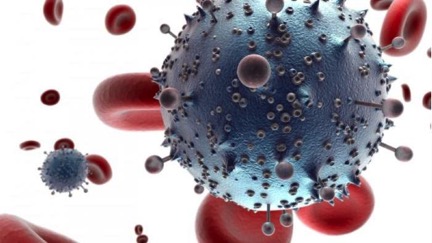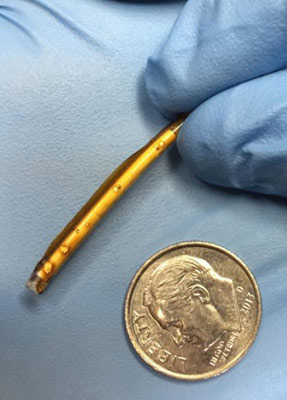HIV/AIDS prevention? Where do I sign up?

(MNT 2016)
A new subdermal implant could provide a constant drug delivery that can stop the spread of HIV whilst treating those who are afflicted.
“Everyone should know this stuff” Level
The human immunodeficiency virus, commonly known as HIV, is a common and deadly disease that is highly active in the world today (Avert 2015). This disease initially attacks the body through the immune system, destroying the white blood cells, known as CD4 cells (Avert 2015). Typically, if HIV is found and treated early with an antiretroviral drug, (a drug that will be explained later in this article), victims can live normally with healthy lives (Avert 2015). However, if left untreated, the last stage of HIV is AIDS (acquired immune deficiency syndrome) (Avert 2015). This stage leaves the body with no immune system and makes the body susceptible to all types of diseases and even death (Avert 2015). This phase of susceptibility begins to develop around 10 to 15 years after initial exposure to HIV, and the worst part is that you might not even know you’re in this stage until it’s too late (Avert 2015).
HIV can be transmitted through bodily fluids, such as semen, blood, vaginal or anal fluids, and breast milk, but it cannot be transmitted through sweat, saliva, or urine (Avert 2015). In most cases, HIV is spread through anal or vaginal sex without a condom (Avert 2015). If you engage in sexual interactions without a condom you can contract HIV and you can die – practice safe sex!
HIV is one of the most widespread diseases contracted in vulnerable populations, such as sub-Saharan Africa (Carstensen 2015). It is most commonly spread between men who engage in sexual activities with other men; within this group, young African American men are the most affected (Owens 2013). To prevent the spread, HIV positive and negative patients engage in antiretroviral therapy (UDHHS 2015), which mainly consists of taking the pill form of antiretroviral (ARV) medication to prevent the spread of HIV and to help fight the disease (Curry 2015). Antiretroviral drugs prevent the HIV cells from replicating, but do not get rid of the cells entirely (UDHHS 2015). This allows the body’s immune system to recover and fight off other diseases (UDHHS 2015). Although this pill-taking method is efficient and useful, most patients forget to take the pill at the same time daily, resulting in drug resistance, increased viral loads, and new infections (Curry 2015).
Through extensive research and trials conducted at the Oak Crest Institute of Science (OCIS), in Pasadena, CA, a new subdermal implant could provide a constant drug delivery that can stop the spread of HIV whilst treating those who are afflicted (Curry 2015). Scientists and researchers from OCIS have effectively created a small flexible tube implant, about 40mm in length, that successfully delivers a sustained release of ARV, specifically the prodrug tenofovir alafenamide, for up to 40 days (see figure below) (OCIS 2015).

(Writer 2015)
To insert it into the body, the tube is placed under the skin on the upper arm of the patient (OCIS 2015). This is similar to the method as implanting contraceptives such as Nexplanon(TM), except on the upper arm (this is further explained in the screencast above) (OCIS 2015). The side effects of the subdermal implant, such as dizziness, fatigue, pain and nerve problems, anemia, vomiting, diarrhea, and rashes, are negligible compared the effectiveness of preventing HIV and the spread of it (Carstensen 2015). Having this subdermal implant would allow for an automatic release of the drug so that the patient does not have to remember to take the pill at the same time everyday (Curry 2015). Having a consistent dosage of ARV delivered into the body daily is critical for protection against HIV and other viral diseases (Anderson 2016).
This implant works by releasing the prodrug tenofovir alafenamide (see screencast for details) (Curry 2015). This treatment “…is roughly ten times more potent against HIV than tenofovir disoproxil fumarate, another tenofovir prodrug that has been shown to prevent sexually transmitted HIV when used as a pre-exposure prophylaxis,” claims Dr. Marc Baum, the founder and president of OCIS (Curry 2015).
This new subdermal implant could reinvent and improve the way we treat HIV forever, as adherence will be entirely eliminated (Anderson 2016). “This novel device will revolutionize how we treat or prevent HIV/AIDS,” Baum said (Anderson 2016). “It delivers powerful HIV-stopping drugs and eliminates one of the key obstacles in HIV/AIDS prevention — adherence to proper dosing regimens” (Anderson 2016).
To test the subdermal implant (containing tenofovir alafenamide), scientists used four healthy dogs and collected their plasma samples for over 40 days (Carstensen 2015). To collect data, the scientists measured the amount of tenofovir alafenamide in the dog’s immune cells (Carstensen 2015). In testing the dogs, the scientists learned that the drug was released at a potency rate that was 30 times the concentration that is actually needed to prevent an individual from contracting HIV (Carstensen 2015).
Looking towards the future, researchers and scientists are currently taking big steps forward by testing the implant and drug combination on humans instead of animals (Anderson 2016). “We are very pleased with the results of our preliminary studies and are working diligently to develop a subdermal implant for HIV prevention that will remain effective for a full 12 months,” says Dr. Baum (OCIS 2015). Baum and his team of scientists at OCIS are currently fine-tuning the specifics and waiting on more funding to acclaim FDA approval for clinical trials (Carstensen 2015). This new subdermal implant could possibly be just the right technology we need in order to limit the deaths caused by HIV and AIDS.
“For geniuses only” Level
HIV cells are tricky in that after they are introduced into the body, they specifically attack the body’s CD4 cells (Aidsinfo 2015). During this attack, the HIV goes through seven life cycle steps. The first step is binding, where the HIV attaches itself to the outside of the CD4 cell using receptors (Aidsinfo 2015). In the next step, the HIV envelope and CD4 cell membrane join together, allowing the HIV to insert itself into the CD4 cell (Aidsinfo 2015). The next step is reverse transcription (Aidsinfo 2015). Within the CD4 cell HIV converts its genetic material, HIV RNA to HIV DNA, using reverse transcriptase, which allows the HIV to combine with the CD4 cell’s genetic material (Aidsinfo 2015). The next step is integration during which HIV releases integrase to implant its viral DNA into the CD4 cell (Aidsinfo 2015). Once successfully integrated inside the CD4 cell, HIV begins to create protein chains in the replication step, which will be used as building blocks for creating more HIV (Aidsinfo 2015). In the second to last step called assembly, these new HIV proteins and HIV RNA assemble into noninfectious HIV (Aidsinfo 2015). In the final deadly step of the life cycle of HIV, the immature HIV leaves the host CD4 cell and releases protease, breaking up the long immature HIV protein chains (Aidsinfo 2015). This allows for the small HIV proteins to come together to create more viral HIV (Aidsinfo 2015).
Now to stop this replicating life cycle of HIV, tenofovir alafenamide, a specific type of nucleoside reverse transcriptase inhibitor (HIV drug group known as NRTIs), is introduced into the body through orally taken drugs (for now) (Baum 2015). What NRTIs do is that they block an HIV specific enzyme, called reverse transcriptase (Baum 2015). This reverse transcriptase allows HIV cells to replicate, so by blocking it with the tenofovir alafenamide, the replication of HIV cells is stopped, therefore reducing the amount of HIV in the body (CDC 2015).
Knowing how dangerously fast the HIV cells can replicate gives all the more reason to look towards more research on a more permanent subdermal implant. Patients who build up adherence to the drugs through inconsistent ingestion are a risk to themselves and others. Tenofovir alafenamide, although not a cure for HIV, definitely helps keep the HIV cells dormant and out of action (Baum 2015). The sustained release of TAF through the subdermal implant is as close as one’s going to get to a cure for HIV at this point in time (Baum 2015).
Impress your friends and family with these three related facts:
Fact 1: Since HIV/AIDS began rapidly spreading in the U.S., an estimated 636,000 have died because of it (Owens 2013).
Fact 2: Every 9.5 minutes, someone in the U.S. gets infected with HIV (Owens 2013).
Fact 3: It’s most commonly spread between men who engage in sexual activities with other men; within this group, young African American men are the most affected (Owens 2013).
Author: This article was created by Morgan McDougal, a senior at Choate Rosemary Hall in Wallingford, CT. Morgan’s spirit animal is a baby sloth. Someday, Morgan will be famous for being the first person to simultaneously play piano, saxophone, and the bagpipes.

Works Cited
Aidsinfo. (2015). “The HIV life cycle.” AIDS info. (Accessed, February 24, 2016). https://aidsinfo.nih.gov/education-materials/fact-sheets/19/73/the-hiv-life-cycle
Admin. (2016). “The Problem.” Red & Party. (Accessed, February 24, 2016). http://www.redparty.org/the-problem
Anderson-Minshall, J. (2015). “Never take another HIV pill?” HivPlus magazine. (Accessed on February 1, 2016). http://www.hivplusmag.com/treatment/research-breakthroughs/2015/05/07/never-take-another-hiv-pill
(Avert) National Institute of Allergy and Infectious Diseases (2009), UNAIDS (2014), Healthline (2014) (2015) “What are HIV and AIDS?” Avert. (Accessed, February 13, 2016). http://www.avert.org/about-hiv-aids/what-hiv-aids
Baum M. (2015) “Pharmacokinetics of long-acting tenofovir alafenamide (GS-73420) subdermal implant for HIV prophylaxis.” Europe PMC. (Accessed, February 24, 2016) http://europepmc.org/articles/pmc4468692
Carstensen, M. (2015). “Scientists design implantable device for long-acting HIV prevention.” Fox News. (Accessed, February 1, 2016). http://www.foxnews.com/health/2015/05/05/scientists-design-implantable-device-for-long-acting-hiv-prevention.html
CDC. (2015). “About HIV/AIDS.” Centers for Disease Control and Prevention. (Accessed, February 24, 2016). http://www.cdc.gov/hiv/basics/whatishiv.html
Cobain, E. (2003). “CD4: T-cell surface glycoprotein.” Davidson. (Accessed, February 24, 2016). http://www.bio.davidson.edu/Courses/Molbio/MolStudents/spring2003/Cobain/geneprotein.html
Curry, T. (2015) “HIV treatment on demand: New implant could deliver antiretrovirals for 12 months.” HIV Equal. (Accessed, February 1, 2016). http://www.hivequal.org/hiv-equal-online/hiv-treatment-on-demand-new-implant-could-deliver-antiretrovirals-for-12-months
Elsevier. (2005). “Scapular Region.” Relx Group. (Accessed, February 24, 2016). http://www.us.elsevierhealth.com/media/us/samplechapters/9780323037440/9780323037440.pdf
Writer, M. (2015). “Revolutionary anti-HIV skin implant developed.” Headlines, Health. (Accessed, February 18, 2016). www.sciencedaily.com/releases/2015/04/150428091928.htm
(MNT) Medical News Today. (2016). “HIV/AIDS news.” Medical News Today. (Accessed, February 22, 2016). http://www.medicalnewstoday.com/categories/hiv-aids
(OCIS) Oak Crest Institute of Science. (2015). “Stopping HIV in its tracks: New subdermal implant delivers potent antiretroviral drugs.” ScienceDaily. (accessed February 1, 2016). www.sciencedaily.com/releases/2015/04/150428091928.htm
Owens, C. (2013). “10 Interesting facts about HIV/AIDS in the US.” Borgen Project. (Accessed, February 1, 2016). http://borgenproject.org/10-interesting-facts-hivaids-us/
(UDHHS 1) U.S. Department of Health and Human Services. (2015). “How is HIV treated?” Aids.gov. (Accessed, February 18, 2016). https://www.aids.gov/hiv-aids-basics/just-diagnosed-with-hiv-aids/treatment-options/overview-of-hiv-treatments/
(UDHHS) U.S. Department of Health and Human Services. (2015). “The global HIV/AIDS epidemic” Aids.gov. (Accessed, February 22, 2016). https://www.aids.gov/federal-resources/around-the-world/global-aids-overview/

Leave a Reply